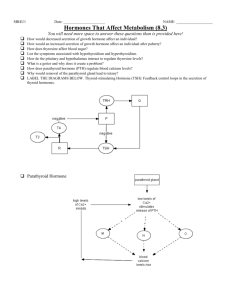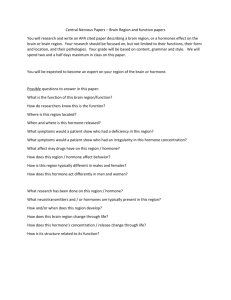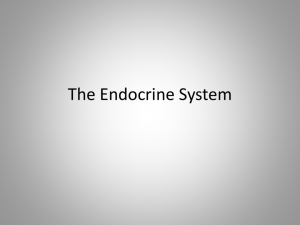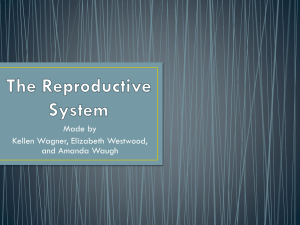homeostasis hw ch 39, 40, 45 ap bio dr weiner
advertisement
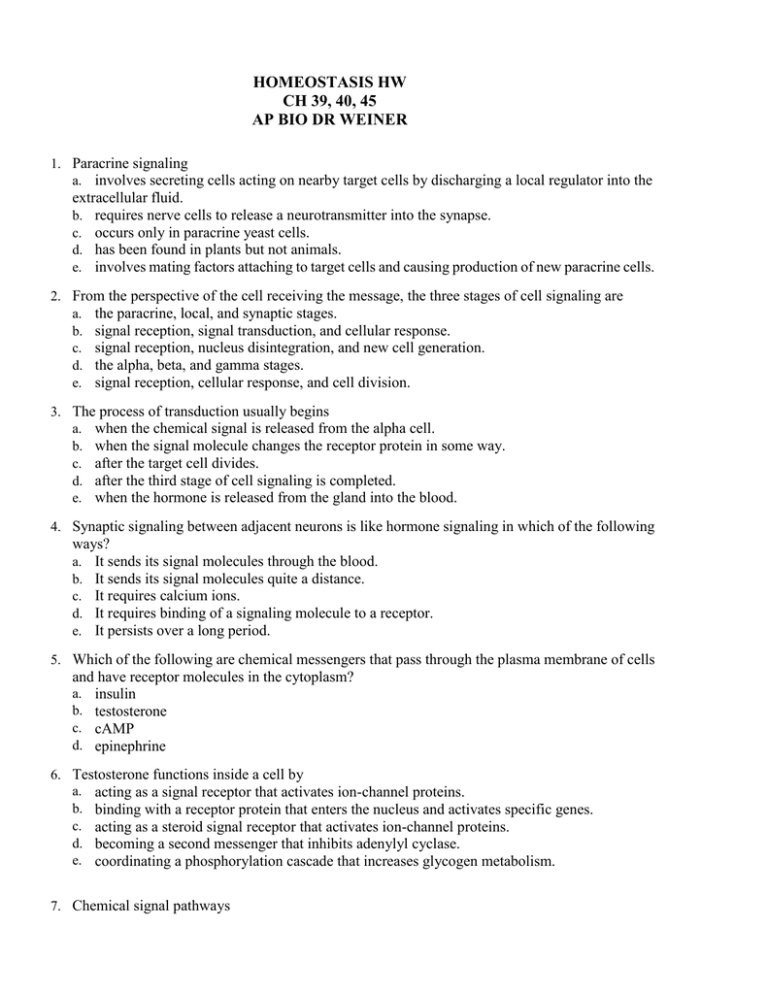
HOMEOSTASIS HW CH 39, 40, 45 AP BIO DR WEINER 1. Paracrine signaling a. involves secreting cells acting on nearby target cells by discharging a local regulator into the extracellular fluid. b. requires nerve cells to release a neurotransmitter into the synapse. c. occurs only in paracrine yeast cells. d. has been found in plants but not animals. e. involves mating factors attaching to target cells and causing production of new paracrine cells. 2. From the perspective of the cell receiving the message, the three stages of cell signaling are a. the paracrine, local, and synaptic stages. b. signal reception, signal transduction, and cellular response. c. signal reception, nucleus disintegration, and new cell generation. d. the alpha, beta, and gamma stages. e. signal reception, cellular response, and cell division. 3. The process of transduction usually begins a. when the chemical signal is released from the alpha cell. b. when the signal molecule changes the receptor protein in some way. c. after the target cell divides. d. after the third stage of cell signaling is completed. e. when the hormone is released from the gland into the blood. 4. Synaptic signaling between adjacent neurons is like hormone signaling in which of the following ways? a. It sends its signal molecules through the blood. b. It sends its signal molecules quite a distance. c. It requires calcium ions. d. It requires binding of a signaling molecule to a receptor. e. It persists over a long period. 5. Which of the following are chemical messengers that pass through the plasma membrane of cells and have receptor molecules in the cytoplasm? a. insulin b. testosterone c. cAMP d. epinephrine 6. Testosterone functions inside a cell by a. acting as a signal receptor that activates ion-channel proteins. b. binding with a receptor protein that enters the nucleus and activates specific genes. c. acting as a steroid signal receptor that activates ion-channel proteins. d. becoming a second messenger that inhibits adenylyl cyclase. e. coordinating a phosphorylation cascade that increases glycogen metabolism. 7. Chemical signal pathways a. b. c. d. operate in animals, but not in plants. are absent in bacteria, but are plentiful in yeast. involve the release of hormones into the blood. often involve the binding of signal molecules to a protein on the surface of a target cell. e. use hydrophilic molecules to activate enzymes. 8. A drug designed to inhibit the response of cells to testosterone would almost certainly result in which of the following? a. lower cytoplasmic levels of cAMP b. an increase in receptor tyrosine kinase activity c. a decrease in transcriptional activity of certain genes d. an increase in cytosolic calcium concentration e. a decrease in G-protein activity 9. At puberty, an adolescent female body changes in both structure and function of several organ systems, primarily under the influence of changing concentrations of estrogens and other steroid hormones. How can one hormone, such as estrogen, mediate so many effects? a. Estrogen is produced in very large concentration and therefore diffuses widely. b. Estrogen has specific receptors inside several cell types, but each cell responds in the same way to its binding. c. Estrogen is kept away from the surface of any cells not able to bind it at the surface. d. Estrogen binds to specific receptors inside many kinds of cells, each of which have different responses to its binding. e. Estrogen has different shaped receptors for each of several cell types. 10. Lipid-soluble signal molecules, such as testosterone, cross the membranes of all cells but affect only target cells because a. only target cells retain the appropriate DNA segments. b. intracellular receptors are present only in target cells. c. most cells lack the Y chromosome required. d. only target cells possess the cytosolic enzymes that transduce the testosterone. e. only in target cells is testosterone able to initiate the phosphorylation cascade leading to activated transcription factor. 11. The ripening of fruit and the dropping of leaves and fruit are principally controlled by a. auxins b. cytokinins c. indole acetic acid d. ethylene e. carbon dioxide concentration (in air) 12. Which one of the following is not a direct function of either auxin or gibberellin? a. inducing senescence and ripening b. producing apical dominance c. producing positive geotropism of shoots d. stimulating cell elongation e. breaking dormancy in seeds 13. Plant growth regulators can be characterized by all of the following except that they a. b. c. d. e. may act by altering gene expression. have a multiplicity of effects. function independently of other hormones. control plant growth and development. affect division, elongation, and differentiation of cells. 14. If you were shipping green bananas to a supermarket thousands of miles away, which of the following chemicals would you want to eliminate from the plants' environment? a. b. c. d. e. cytokinins ethylene auxin gibberellic acids 15. A short-day plant will flower only when a. days are shorter than nights. b. days are shorter than a certain critical value. c. nights are shorter than a certain critical value. d. nights are longer than a certain critical value. e. days and nights are of equal length. 16. A flash of red light followed by a flash of far-red light given during the middle of the night to a short-day plant will likely a. cause increased flower production. b. have no effect upon flowering. c. inhibit flowering. d. stimulate flowering. e. convert florigen to the active form. 17. Many plants flower in response to day-length cues. Which statement concerning flowering is false? a. As a rule, short-day plants flower in the spring or fall. b. As a rule, long-day plants flower in the summer. c. Long-day plants flower in response to long days, not short nights. d. Flowering in day-neutral plants is not influenced by day length. e. Flowering in short-day plants is controlled by phytochrome. 18. Plants often use changes in day length (photoperiod) to trigger events such as dormancy and flowering. It is logical that plants have evolved this mechanism because photoperiod changes a. are more predictable than air temperature changes. b. alter the amount of energy available to the plant. c. are modified by soil temperature changes. d. can reset the biological clock. e. are correlated with moisture availability. 19. A long-day plant will flower if a. the duration of continuous light exceeds a critical length. b. the duration of continuous light is less than a critical length. c. the duration of continuous darkness exceeds a critical length. d. the duration of continuous darkness is less than a critical length. e. it is kept in continuous far-red light. 20. An example of a properly functioning homeostatic control system is seen when a. the core body temperature of a runner rises gradually from 37°C to 45°C. b. the kidneys excrete salt into the urine when dietary salt levels rise. c. a blood cell shrinks when placed in a solution of salt and water. d. the blood pressure increases in response to an increase in blood volume. e. the level of glucose in the blood is abnormally high whether or not a meal has been eaten. 21. Positive feedback has occurred when a. an increase in blood sugar increases the secretion of a hormone that stores sugar as glycogen. b. a decrease in blood sugar increases the secretion of a hormone that converts glycogen to glucose. c. a nursing infant's sucking increases the secretion of a milk-releasing hormone in the mother. d. an increase in calcium concentration increases the secretion of a hormone that stores calcium in bone. e. a decrease in blood calcium increases the amount of the hormone that releases calcium from bone. 22. An overheated and sick dog has an impaired thermoregulatory response if it a. increases its evaporative heat loss. b. decreases its metabolic heat production. c. increases its body temperature to match the environmental temperature. d. increases its vasodilation in blood vessels near the skin. e. relocates itself to a cooler location. 23. Panting observed in overheated birds and mammals dissipates excess heat by a. countercurrent exchange. b. acclimation. c. vasoconstriction. d. hibernation. e. evaporation. 24. The temperature-regulating center of vertebrate animals is located in the a. medulla oblongata. b. thyroid gland. c. hypothalamus. d. subcutaneous layer of the skin. e. liver. 25. Panting by an overheated dog is an example of a. acclimatization. b. torpor. c. evaporative cooling. d. non-shivering thermogenesis. e. shivering thermogenesis. 26. Metabolism of specialized brown fat depots in certain animals is substantially increased during a. acclimatization. b. torpor. c. evaporative cooling. d. non-shivering thermogenesis. e. shivering thermogenesis. 27. Consider the energy budgets for a human, an elephant, a penguin, a mouse, and a snake. The __________ would have the highest total annual energy expenditure, and the __________ would have the highest energy expenditure per unit mass. a. elephant; mouse b. elephant; human c. human; penguin d. mouse; snake e. penguin; mouse 28. Which of the following is (are) true? a. Hormones regulate cellular functions, and generally negative feedback regulates b. c. d. e. hormone levels. The circulating level of a hormone is held constant through a series of positive feedback loops. Both lipid-soluble hormones and water-soluble hormones bind to intracellular protein receptors. The ducts of endocrine organs release their contents into the bloodstream. Only A and C are true. 29. A cell that contains proteins enabling a hormone to selectively bind to its plasma membrane is called a(n) a. secretory cell. b. plasma cell. c. endocrine cell. d. target cell. e. regulatory cell. 30. Only certain cells in the body are target cells for the steroid hormone aldosterone. Which of the following is the best explanation for why these are the only cells that respond to this hormone? a. Only target cells are exposed to aldosterone. b. Only target cells contain receptors for aldosterone. c. Aldosterone is unable to enter nontarget cells. d. Nontarget cells destroy aldosterone before it can produce its effect. e. Nontarget cells convert aldosterone to a hormone to which they do respond. 31. Which of the following statements about hormones that promote homeostasis is incorrect? a. A stimulus causes an endocrine cell to secrete a particular hormone. b. The hormone travels in the bloodstream to target cells. c. Specific receptors bind with the hormone. d. Signal transduction brings about a response in the target cell. e. This response feeds back to promote the release of more hormone. 32. If a person drinks a large amount of water in a short period of time, he or she may die from water toxicity. ADH can help prevent water retention through interaction with target cells in the a. anterior pituitary. b. posterior pituitary. c. adrenal gland. d. bladder. e. kidney. 33. Blood samples taken from an individual who had been fasting for 24 hours would have which of the following? a. high levels of insulin b. high levels of glucagon c. low levels of insulin d. low levels of glucagon e. both B and C 34. What happens when beta cells of the pancreas release insulin into the blood? a. Blood glucose levels rise to a set point and stimulate glucagon release. b. Body cells take up more glucose. c. The liver breaks down glycogen to glucose. d. Alpha cells are stimulated to release glucose into the blood. e. Both B and D are correct. 35. The cooling effect of perspiring helps organisms maintain a steady body temperature. Which of the following best explains this phenomenon? a. Water has a high heat of vaporization b. Strong hydrophobic interactions exist between water molecules c. Little kinetic energy is required to break hydrogen bonds between water molecules d. Water is less dense as it increases in temperature e. The oxygen-hydrogen bonds within water molecules are difficult to break 36. Physiological adjustments by an ectotherm to cooler seasonal temperatures may include a. An increase in metabolic rate b. Changes in lipid composition of the cell membrane c. Increased vasoconstriction of surface capillaries d. Increased skeletal muscle contractions e. All of the above 37. The key difference between endotherms and ectotherms is a. Ectotherms mainly generate heat from fermentation b. All Ectotherms are aquatic and all endotherms are terrestrial c. Endotherms are cold blooded animals whose body temperature cannot reach that of endotherms d. All ectotherms are invertebrates and all endotherms are vertebrates e. Ectotherms use the environment to warm their bodies while endotherms use internal mechanisms to warm their bodies. Essay Questions 1. Explain how the mammalian hypothalamus regulates body temperature. Describe the physiological effect of vasodilation, vasoconstriction, shivering, and panting/sweating on the maintenance of body temperature. (10 PTS) 2. Blood glucose is maintained at constant levels by two hormones a. What hormones regulate sugar balance and how do they do it? b. Both hormones are protein hormones. How do they induce a response in their target cells? c. How does a cell respond to protein hormones? 3. A plant in the temperate zone is exposed to a summer drought. Discuss how this plant will balance the prevention of excess transpiration with the necessity for photosynthesis. What are some ways plants help prevent water loss? 4. Explain how short day and long day plants flower. 5. Plants in the temperate zone go dormant in the colder weather. Explain: a. Why their leaves turn color b. What effect change in leaf color has on photosynthesis c. What effect does lowered photosynthesis has on the plant d. What triggers leaves to drop and why they do this. 6. In the temperate zone plants renew growth in the spring. a. What triggers this new growth? b. Explain how auxins and cytokinins affect plant growth. c. What effect does an increase in photosynthesis have on the plant





